PSYC1031 Introduction to Psychology: Human vs Animal Language
VerifiedAdded on 2023/06/12
|7
|1915
|462
Essay
AI Summary
This essay explores the fundamental differences between human language and animal communication systems, referencing key qualities such as arbitrariness, discreteness, productivity, and cultural transmission. It analyzes how human language allows for complex and abstract thought, contrasting it with animal communication, which is often limited to immediate needs and lacks the generative capacity of human speech. The essay also touches upon studies involving primates and other animals to highlight the unique aspects of human language, including its ability to convey information about the past, present, and future. Desklib provides access to similar essays and study tools for students seeking to deepen their understanding of psychology and related topics.

Topic
Paraphrase This Document
Need a fresh take? Get an instant paraphrase of this document with our AI Paraphraser

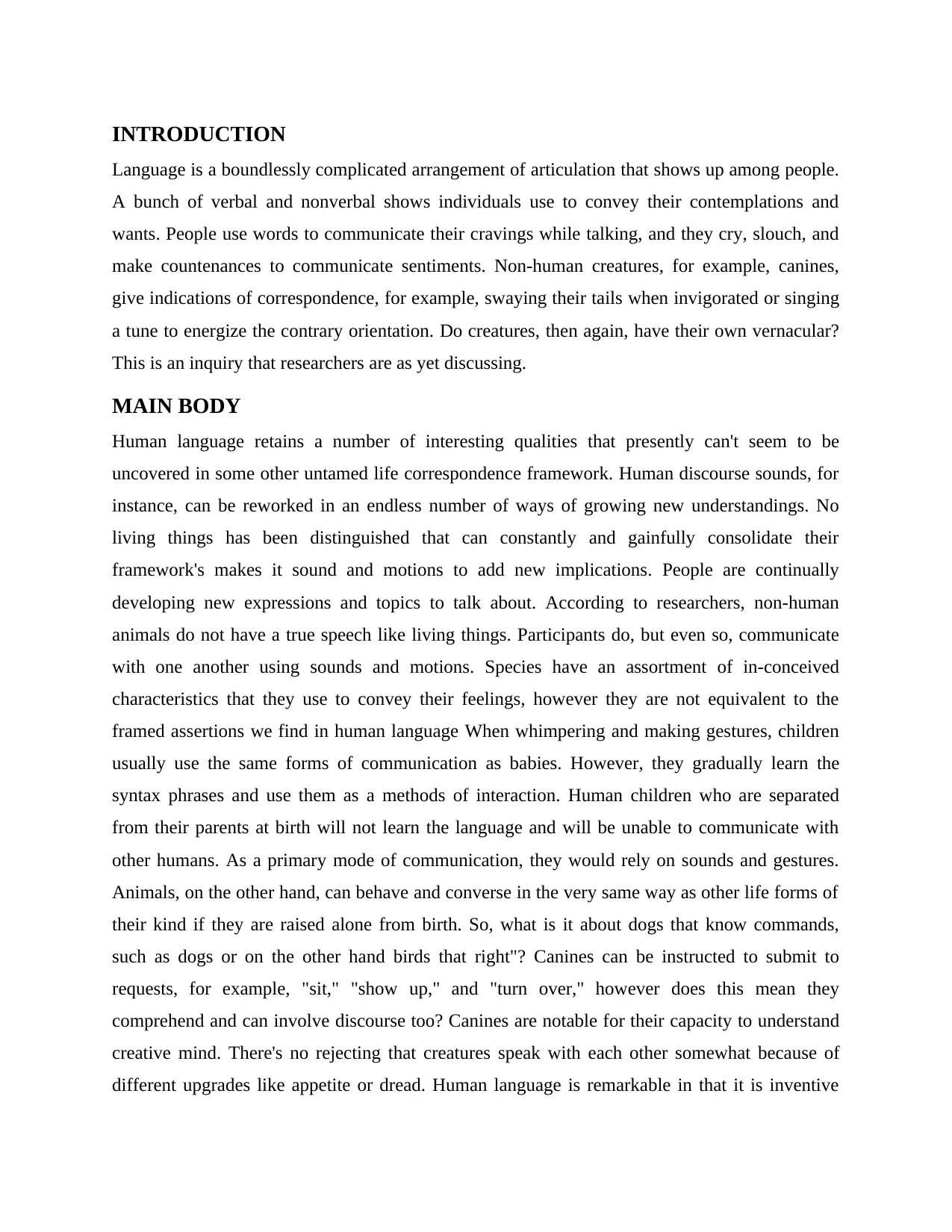
INTRODUCTION
Language is a boundlessly complicated arrangement of articulation that shows up among people.
A bunch of verbal and nonverbal shows individuals use to convey their contemplations and
wants. People use words to communicate their cravings while talking, and they cry, slouch, and
make countenances to communicate sentiments. Non-human creatures, for example, canines,
give indications of correspondence, for example, swaying their tails when invigorated or singing
a tune to energize the contrary orientation. Do creatures, then again, have their own vernacular?
This is an inquiry that researchers are as yet discussing.
MAIN BODY
Human language retains a number of interesting qualities that presently can't seem to be
uncovered in some other untamed life correspondence framework. Human discourse sounds, for
instance, can be reworked in an endless number of ways of growing new understandings. No
living things has been distinguished that can constantly and gainfully consolidate their
framework's makes it sound and motions to add new implications. People are continually
developing new expressions and topics to talk about. According to researchers, non-human
animals do not have a true speech like living things. Participants do, but even so, communicate
with one another using sounds and motions. Species have an assortment of in-conceived
characteristics that they use to convey their feelings, however they are not equivalent to the
framed assertions we find in human language When whimpering and making gestures, children
usually use the same forms of communication as babies. However, they gradually learn the
syntax phrases and use them as a methods of interaction. Human children who are separated
from their parents at birth will not learn the language and will be unable to communicate with
other humans. As a primary mode of communication, they would rely on sounds and gestures.
Animals, on the other hand, can behave and converse in the very same way as other life forms of
their kind if they are raised alone from birth. So, what is it about dogs that know commands,
such as dogs or on the other hand birds that right"? Canines can be instructed to submit to
requests, for example, "sit," "show up," and "turn over," however does this mean they
comprehend and can involve discourse too? Canines are notable for their capacity to understand
creative mind. There's no rejecting that creatures speak with each other somewhat because of
different upgrades like appetite or dread. Human language is remarkable in that it is inventive
Language is a boundlessly complicated arrangement of articulation that shows up among people.
A bunch of verbal and nonverbal shows individuals use to convey their contemplations and
wants. People use words to communicate their cravings while talking, and they cry, slouch, and
make countenances to communicate sentiments. Non-human creatures, for example, canines,
give indications of correspondence, for example, swaying their tails when invigorated or singing
a tune to energize the contrary orientation. Do creatures, then again, have their own vernacular?
This is an inquiry that researchers are as yet discussing.
MAIN BODY
Human language retains a number of interesting qualities that presently can't seem to be
uncovered in some other untamed life correspondence framework. Human discourse sounds, for
instance, can be reworked in an endless number of ways of growing new understandings. No
living things has been distinguished that can constantly and gainfully consolidate their
framework's makes it sound and motions to add new implications. People are continually
developing new expressions and topics to talk about. According to researchers, non-human
animals do not have a true speech like living things. Participants do, but even so, communicate
with one another using sounds and motions. Species have an assortment of in-conceived
characteristics that they use to convey their feelings, however they are not equivalent to the
framed assertions we find in human language When whimpering and making gestures, children
usually use the same forms of communication as babies. However, they gradually learn the
syntax phrases and use them as a methods of interaction. Human children who are separated
from their parents at birth will not learn the language and will be unable to communicate with
other humans. As a primary mode of communication, they would rely on sounds and gestures.
Animals, on the other hand, can behave and converse in the very same way as other life forms of
their kind if they are raised alone from birth. So, what is it about dogs that know commands,
such as dogs or on the other hand birds that right"? Canines can be instructed to submit to
requests, for example, "sit," "show up," and "turn over," however does this mean they
comprehend and can involve discourse too? Canines are notable for their capacity to understand
creative mind. There's no rejecting that creatures speak with each other somewhat because of
different upgrades like appetite or dread. Human language is remarkable in that it is inventive
⊘ This is a preview!⊘
Do you want full access?
Subscribe today to unlock all pages.

Trusted by 1+ million students worldwide
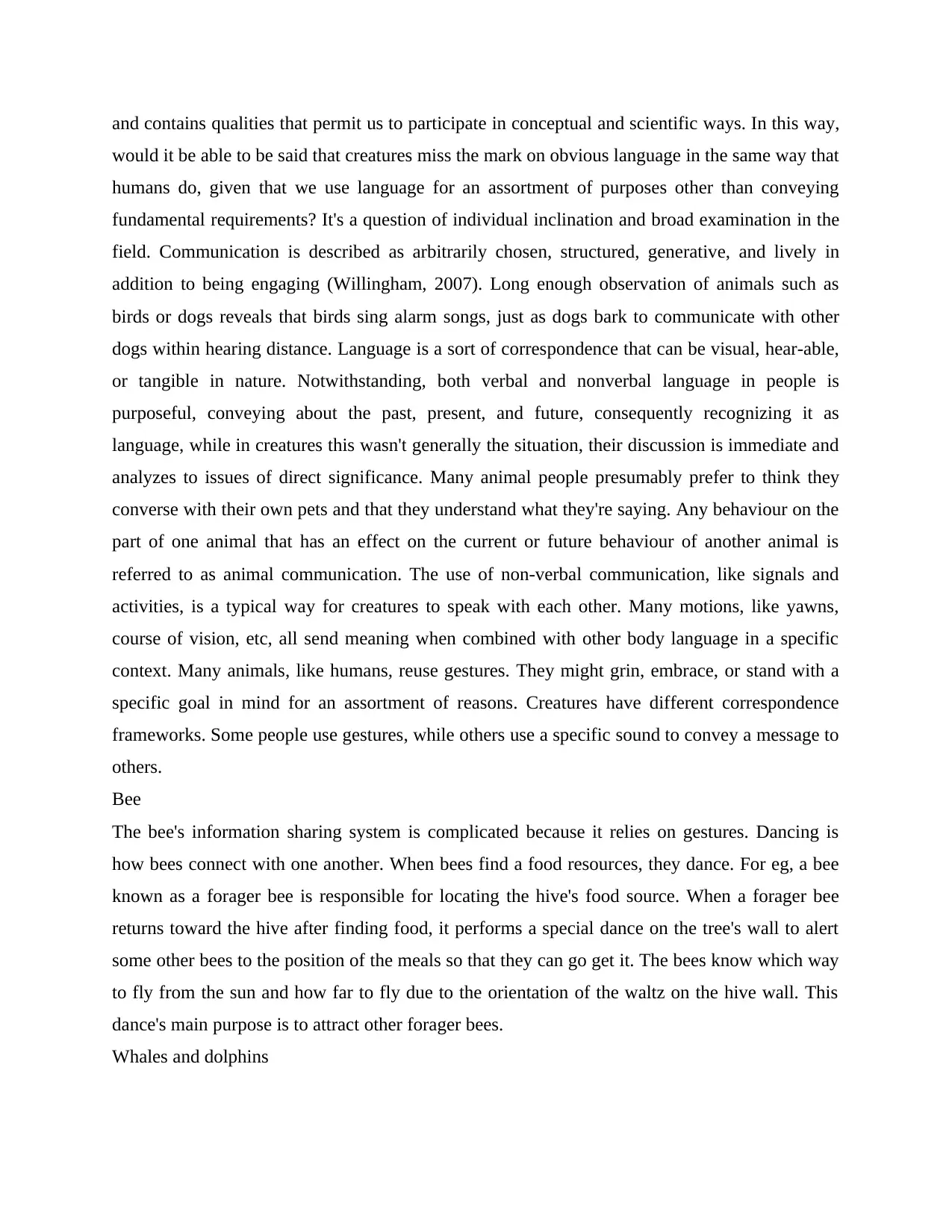
and contains qualities that permit us to participate in conceptual and scientific ways. In this way,
would it be able to be said that creatures miss the mark on obvious language in the same way that
humans do, given that we use language for an assortment of purposes other than conveying
fundamental requirements? It's a question of individual inclination and broad examination in the
field. Communication is described as arbitrarily chosen, structured, generative, and lively in
addition to being engaging (Willingham, 2007). Long enough observation of animals such as
birds or dogs reveals that birds sing alarm songs, just as dogs bark to communicate with other
dogs within hearing distance. Language is a sort of correspondence that can be visual, hear-able,
or tangible in nature. Notwithstanding, both verbal and nonverbal language in people is
purposeful, conveying about the past, present, and future, consequently recognizing it as
language, while in creatures this wasn't generally the situation, their discussion is immediate and
analyzes to issues of direct significance. Many animal people presumably prefer to think they
converse with their own pets and that they understand what they're saying. Any behaviour on the
part of one animal that has an effect on the current or future behaviour of another animal is
referred to as animal communication. The use of non-verbal communication, like signals and
activities, is a typical way for creatures to speak with each other. Many motions, like yawns,
course of vision, etc, all send meaning when combined with other body language in a specific
context. Many animals, like humans, reuse gestures. They might grin, embrace, or stand with a
specific goal in mind for an assortment of reasons. Creatures have different correspondence
frameworks. Some people use gestures, while others use a specific sound to convey a message to
others.
Bee
The bee's information sharing system is complicated because it relies on gestures. Dancing is
how bees connect with one another. When bees find a food resources, they dance. For eg, a bee
known as a forager bee is responsible for locating the hive's food source. When a forager bee
returns toward the hive after finding food, it performs a special dance on the tree's wall to alert
some other bees to the position of the meals so that they can go get it. The bees know which way
to fly from the sun and how far to fly due to the orientation of the waltz on the hive wall. This
dance's main purpose is to attract other forager bees.
Whales and dolphins
would it be able to be said that creatures miss the mark on obvious language in the same way that
humans do, given that we use language for an assortment of purposes other than conveying
fundamental requirements? It's a question of individual inclination and broad examination in the
field. Communication is described as arbitrarily chosen, structured, generative, and lively in
addition to being engaging (Willingham, 2007). Long enough observation of animals such as
birds or dogs reveals that birds sing alarm songs, just as dogs bark to communicate with other
dogs within hearing distance. Language is a sort of correspondence that can be visual, hear-able,
or tangible in nature. Notwithstanding, both verbal and nonverbal language in people is
purposeful, conveying about the past, present, and future, consequently recognizing it as
language, while in creatures this wasn't generally the situation, their discussion is immediate and
analyzes to issues of direct significance. Many animal people presumably prefer to think they
converse with their own pets and that they understand what they're saying. Any behaviour on the
part of one animal that has an effect on the current or future behaviour of another animal is
referred to as animal communication. The use of non-verbal communication, like signals and
activities, is a typical way for creatures to speak with each other. Many motions, like yawns,
course of vision, etc, all send meaning when combined with other body language in a specific
context. Many animals, like humans, reuse gestures. They might grin, embrace, or stand with a
specific goal in mind for an assortment of reasons. Creatures have different correspondence
frameworks. Some people use gestures, while others use a specific sound to convey a message to
others.
Bee
The bee's information sharing system is complicated because it relies on gestures. Dancing is
how bees connect with one another. When bees find a food resources, they dance. For eg, a bee
known as a forager bee is responsible for locating the hive's food source. When a forager bee
returns toward the hive after finding food, it performs a special dance on the tree's wall to alert
some other bees to the position of the meals so that they can go get it. The bees know which way
to fly from the sun and how far to fly due to the orientation of the waltz on the hive wall. This
dance's main purpose is to attract other forager bees.
Whales and dolphins
Paraphrase This Document
Need a fresh take? Get an instant paraphrase of this document with our AI Paraphraser
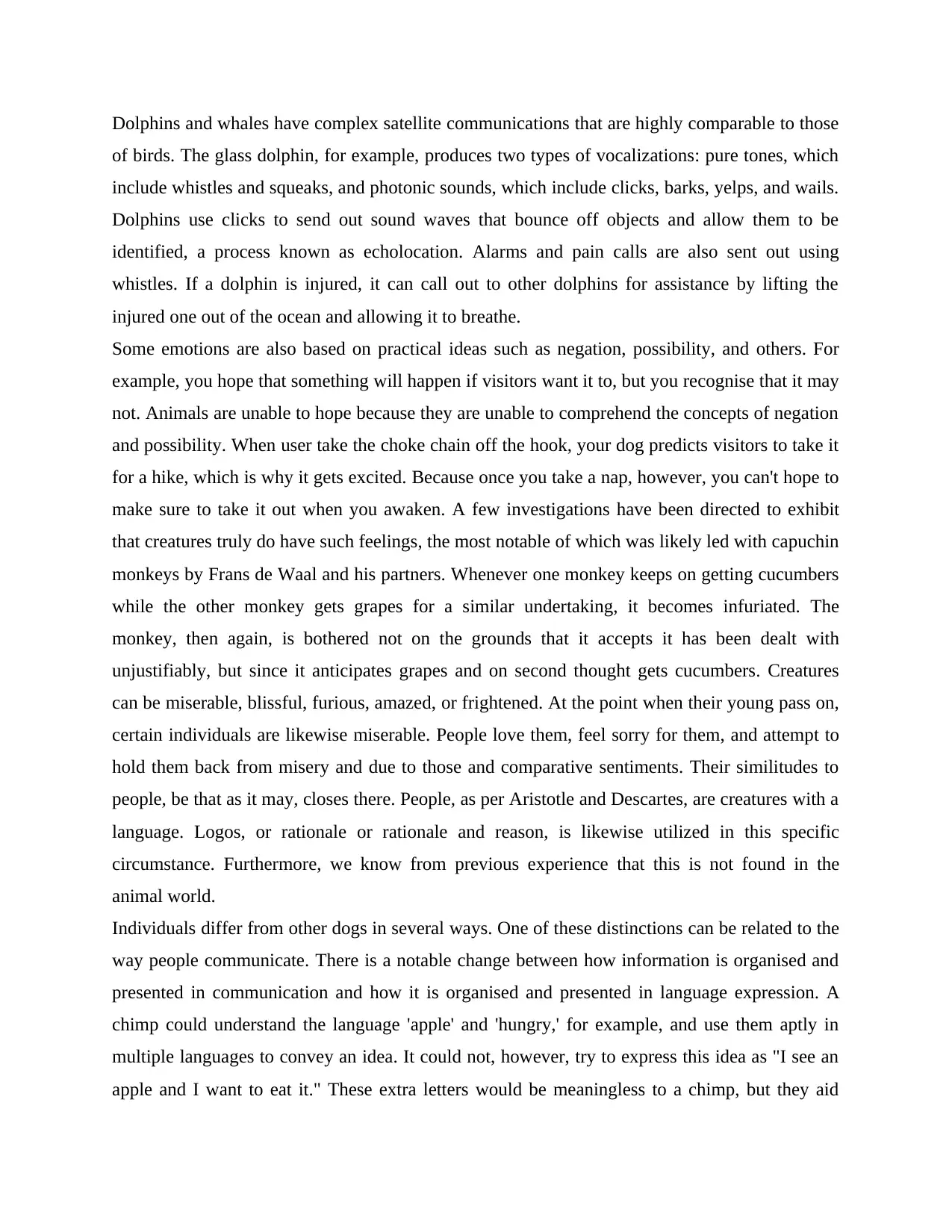
Dolphins and whales have complex satellite communications that are highly comparable to those
of birds. The glass dolphin, for example, produces two types of vocalizations: pure tones, which
include whistles and squeaks, and photonic sounds, which include clicks, barks, yelps, and wails.
Dolphins use clicks to send out sound waves that bounce off objects and allow them to be
identified, a process known as echolocation. Alarms and pain calls are also sent out using
whistles. If a dolphin is injured, it can call out to other dolphins for assistance by lifting the
injured one out of the ocean and allowing it to breathe.
Some emotions are also based on practical ideas such as negation, possibility, and others. For
example, you hope that something will happen if visitors want it to, but you recognise that it may
not. Animals are unable to hope because they are unable to comprehend the concepts of negation
and possibility. When user take the choke chain off the hook, your dog predicts visitors to take it
for a hike, which is why it gets excited. Because once you take a nap, however, you can't hope to
make sure to take it out when you awaken. A few investigations have been directed to exhibit
that creatures truly do have such feelings, the most notable of which was likely led with capuchin
monkeys by Frans de Waal and his partners. Whenever one monkey keeps on getting cucumbers
while the other monkey gets grapes for a similar undertaking, it becomes infuriated. The
monkey, then again, is bothered not on the grounds that it accepts it has been dealt with
unjustifiably, but since it anticipates grapes and on second thought gets cucumbers. Creatures
can be miserable, blissful, furious, amazed, or frightened. At the point when their young pass on,
certain individuals are likewise miserable. People love them, feel sorry for them, and attempt to
hold them back from misery and due to those and comparative sentiments. Their similitudes to
people, be that as it may, closes there. People, as per Aristotle and Descartes, are creatures with a
language. Logos, or rationale or rationale and reason, is likewise utilized in this specific
circumstance. Furthermore, we know from previous experience that this is not found in the
animal world.
Individuals differ from other dogs in several ways. One of these distinctions can be related to the
way people communicate. There is a notable change between how information is organised and
presented in communication and how it is organised and presented in language expression. A
chimp could understand the language 'apple' and 'hungry,' for example, and use them aptly in
multiple languages to convey an idea. It could not, however, try to express this idea as "I see an
apple and I want to eat it." These extra letters would be meaningless to a chimp, but they aid
of birds. The glass dolphin, for example, produces two types of vocalizations: pure tones, which
include whistles and squeaks, and photonic sounds, which include clicks, barks, yelps, and wails.
Dolphins use clicks to send out sound waves that bounce off objects and allow them to be
identified, a process known as echolocation. Alarms and pain calls are also sent out using
whistles. If a dolphin is injured, it can call out to other dolphins for assistance by lifting the
injured one out of the ocean and allowing it to breathe.
Some emotions are also based on practical ideas such as negation, possibility, and others. For
example, you hope that something will happen if visitors want it to, but you recognise that it may
not. Animals are unable to hope because they are unable to comprehend the concepts of negation
and possibility. When user take the choke chain off the hook, your dog predicts visitors to take it
for a hike, which is why it gets excited. Because once you take a nap, however, you can't hope to
make sure to take it out when you awaken. A few investigations have been directed to exhibit
that creatures truly do have such feelings, the most notable of which was likely led with capuchin
monkeys by Frans de Waal and his partners. Whenever one monkey keeps on getting cucumbers
while the other monkey gets grapes for a similar undertaking, it becomes infuriated. The
monkey, then again, is bothered not on the grounds that it accepts it has been dealt with
unjustifiably, but since it anticipates grapes and on second thought gets cucumbers. Creatures
can be miserable, blissful, furious, amazed, or frightened. At the point when their young pass on,
certain individuals are likewise miserable. People love them, feel sorry for them, and attempt to
hold them back from misery and due to those and comparative sentiments. Their similitudes to
people, be that as it may, closes there. People, as per Aristotle and Descartes, are creatures with a
language. Logos, or rationale or rationale and reason, is likewise utilized in this specific
circumstance. Furthermore, we know from previous experience that this is not found in the
animal world.
Individuals differ from other dogs in several ways. One of these distinctions can be related to the
way people communicate. There is a notable change between how information is organised and
presented in communication and how it is organised and presented in language expression. A
chimp could understand the language 'apple' and 'hungry,' for example, and use them aptly in
multiple languages to convey an idea. It could not, however, try to express this idea as "I see an
apple and I want to eat it." These extra letters would be meaningless to a chimp, but they aid
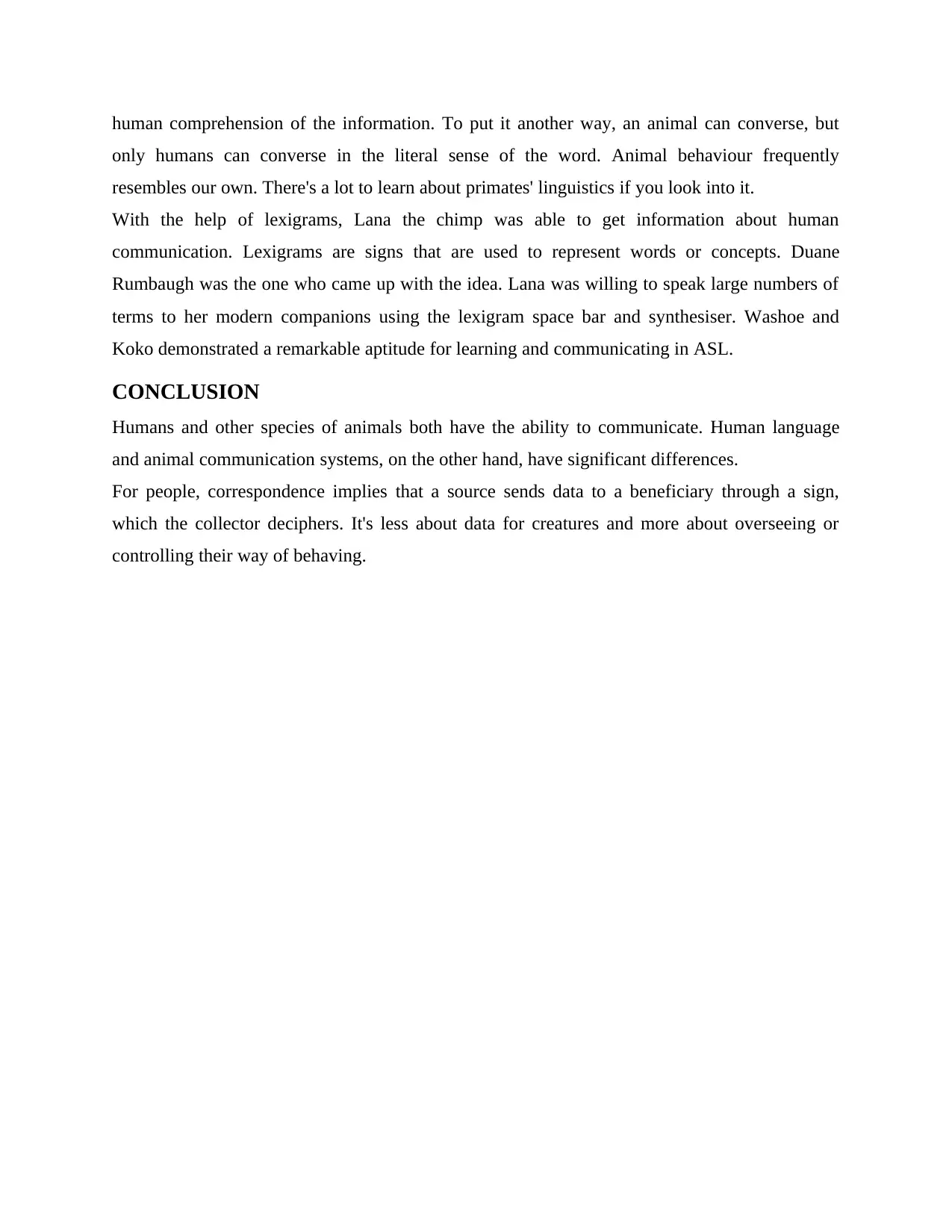
human comprehension of the information. To put it another way, an animal can converse, but
only humans can converse in the literal sense of the word. Animal behaviour frequently
resembles our own. There's a lot to learn about primates' linguistics if you look into it.
With the help of lexigrams, Lana the chimp was able to get information about human
communication. Lexigrams are signs that are used to represent words or concepts. Duane
Rumbaugh was the one who came up with the idea. Lana was willing to speak large numbers of
terms to her modern companions using the lexigram space bar and synthesiser. Washoe and
Koko demonstrated a remarkable aptitude for learning and communicating in ASL.
CONCLUSION
Humans and other species of animals both have the ability to communicate. Human language
and animal communication systems, on the other hand, have significant differences.
For people, correspondence implies that a source sends data to a beneficiary through a sign,
which the collector deciphers. It's less about data for creatures and more about overseeing or
controlling their way of behaving.
only humans can converse in the literal sense of the word. Animal behaviour frequently
resembles our own. There's a lot to learn about primates' linguistics if you look into it.
With the help of lexigrams, Lana the chimp was able to get information about human
communication. Lexigrams are signs that are used to represent words or concepts. Duane
Rumbaugh was the one who came up with the idea. Lana was willing to speak large numbers of
terms to her modern companions using the lexigram space bar and synthesiser. Washoe and
Koko demonstrated a remarkable aptitude for learning and communicating in ASL.
CONCLUSION
Humans and other species of animals both have the ability to communicate. Human language
and animal communication systems, on the other hand, have significant differences.
For people, correspondence implies that a source sends data to a beneficiary through a sign,
which the collector deciphers. It's less about data for creatures and more about overseeing or
controlling their way of behaving.
⊘ This is a preview!⊘
Do you want full access?
Subscribe today to unlock all pages.

Trusted by 1+ million students worldwide
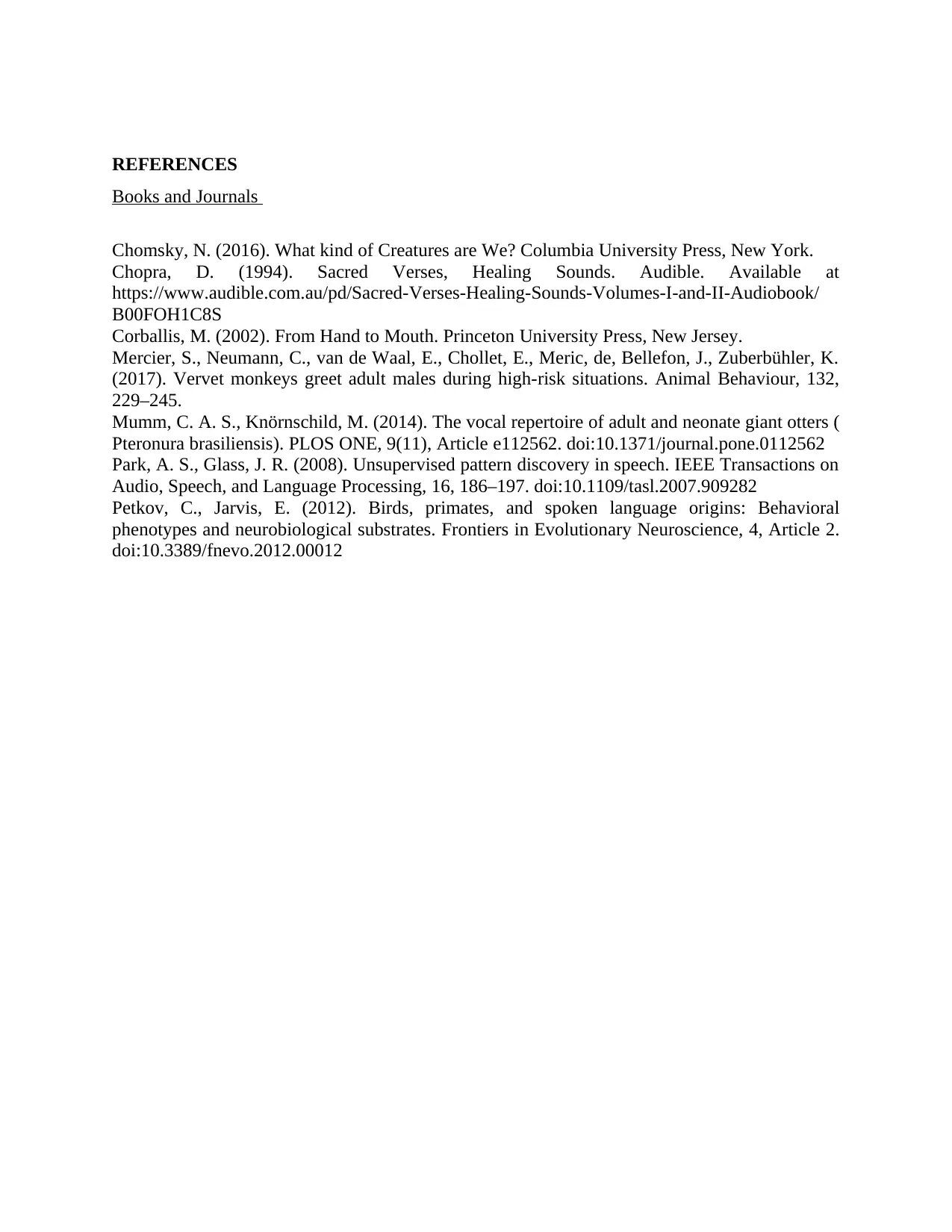
REFERENCES
Books and Journals
Chomsky, N. (2016). What kind of Creatures are We? Columbia University Press, New York.
Chopra, D. (1994). Sacred Verses, Healing Sounds. Audible. Available at
https://www.audible.com.au/pd/Sacred-Verses-Healing-Sounds-Volumes-I-and-II-Audiobook/
B00FOH1C8S
Corballis, M. (2002). From Hand to Mouth. Princeton University Press, New Jersey.
Mercier, S., Neumann, C., van de Waal, E., Chollet, E., Meric, de, Bellefon, J., Zuberbühler, K.
(2017). Vervet monkeys greet adult males during high-risk situations. Animal Behaviour, 132,
229–245.
Mumm, C. A. S., Knörnschild, M. (2014). The vocal repertoire of adult and neonate giant otters (
Pteronura brasiliensis). PLOS ONE, 9(11), Article e112562. doi:10.1371/journal.pone.0112562
Park, A. S., Glass, J. R. (2008). Unsupervised pattern discovery in speech. IEEE Transactions on
Audio, Speech, and Language Processing, 16, 186–197. doi:10.1109/tasl.2007.909282
Petkov, C., Jarvis, E. (2012). Birds, primates, and spoken language origins: Behavioral
phenotypes and neurobiological substrates. Frontiers in Evolutionary Neuroscience, 4, Article 2.
doi:10.3389/fnevo.2012.00012
Books and Journals
Chomsky, N. (2016). What kind of Creatures are We? Columbia University Press, New York.
Chopra, D. (1994). Sacred Verses, Healing Sounds. Audible. Available at
https://www.audible.com.au/pd/Sacred-Verses-Healing-Sounds-Volumes-I-and-II-Audiobook/
B00FOH1C8S
Corballis, M. (2002). From Hand to Mouth. Princeton University Press, New Jersey.
Mercier, S., Neumann, C., van de Waal, E., Chollet, E., Meric, de, Bellefon, J., Zuberbühler, K.
(2017). Vervet monkeys greet adult males during high-risk situations. Animal Behaviour, 132,
229–245.
Mumm, C. A. S., Knörnschild, M. (2014). The vocal repertoire of adult and neonate giant otters (
Pteronura brasiliensis). PLOS ONE, 9(11), Article e112562. doi:10.1371/journal.pone.0112562
Park, A. S., Glass, J. R. (2008). Unsupervised pattern discovery in speech. IEEE Transactions on
Audio, Speech, and Language Processing, 16, 186–197. doi:10.1109/tasl.2007.909282
Petkov, C., Jarvis, E. (2012). Birds, primates, and spoken language origins: Behavioral
phenotypes and neurobiological substrates. Frontiers in Evolutionary Neuroscience, 4, Article 2.
doi:10.3389/fnevo.2012.00012
1 out of 7
Related Documents
Your All-in-One AI-Powered Toolkit for Academic Success.
+13062052269
info@desklib.com
Available 24*7 on WhatsApp / Email
![[object Object]](/_next/static/media/star-bottom.7253800d.svg)
Unlock your academic potential
Copyright © 2020–2025 A2Z Services. All Rights Reserved. Developed and managed by ZUCOL.




